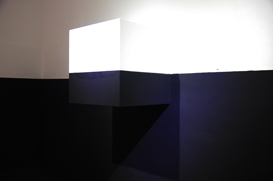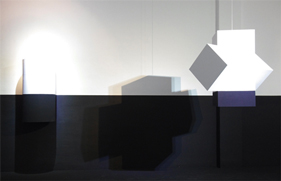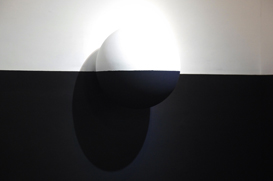|
  
Ma Jun - 马军, Ink - 水墨, ink - 墨, gypsum - 石膏, variable sized - 尺寸可变, 2014.
|
|
présentation - 展览介绍 :
Curator: Chai Jianzhong
Ink is one of China’s traditional resources.
Nowadays the term has acquired different connotations:
Original ink (referring to a certain traditional style of development, as the one used in ink on paper); spatial ink (referring to the Tai Chi concepts of Yin and Yang and black and white, as in hyper-planarity); conceptual ink (the explanation of the connection between different cultural forms, as installation, performing act, written text and so on).
Under the pressure of the open language context’s mutual frictions, ink takes different curious forms.
Contemporary art, having a global range, arises a reflection in Chinese ink:
How can the traditional paradigms of calligraphy maintain the emotional depth and understanding of art?
The ink experiment of Ma Jun guides us into his unique linguistic experiment and experiencing space.
This exhibition will be displayed in two spaces.
The first space will be dedicated to the characteristics of “Emptiness” and “Water”.
Purely white, composed of a Chinese traditional wall printed in 3D, different from real walls made of bricks, this space establishes a dialogue between the real and the potential world, the physical and the virtual space and existing and imaginary concepts.
Facing this wall is like entering a written and possibly planned space.
3D printing technology reveals the decomposition of particles and the plastic character of the composition, just like the emptiness characteristic of water and ink. The movement between ink and water in Chinese ink, indeed, leaving traces of ink, creates images.
When there is only water what is left is clean and potential fantasy.
The boundaries of the wall, real and virtual, represents the invisible and rare things of this epoch.
The second space is dedicated to “Emptiness“ and “Ink”.
The different models of geometric forms, representing the complex forms existing on the Earth, float in a pool of ink and, when the water is dried, leave ink marks.
At first, we can immediately feel the relation between space and volumes.
Getting into a deeper lever, we can then feel the relation between the pure virtual space (the outer space) and the potentially virtual (the movement of ink) and virtual (the geometric forms) space. We are then made to ponder over the relation between ink (representing the Chinese culture) and the virtual space (representing the universe).
This is Ma Jun creative narrative on the language and experience of ink.
When discussing about ink, we have to consider the endless relation between tradition and contemporary, experience and concept, China and the world.
Art, on the one hand, is constantly trying to open the barricade or to overcome the impasse for a potential relation and, on the other hand, is searching for a more rational and essential relation.
Which one do you think is the purpose of Ma Jun?
策展人: 柴中建
2014年4月6日下午3点,马军实验性个展于在3画廊举办开幕酒会。不同于以往的瓷器作品,马军这次的展览,是基于画廊已有的空间而对整个展厅做的一次规划和设计,最后将整个空间做成了他的作品。在第一个展厅,他利用3D雕刻技术打印了一面纯白的但是具有中国传统院墙形体的墙面,和展厅本身的纯白结合在一起。第二个展厅则被设计成一个可体验性的水墨空间,在此,他彻底颠覆人们对传统水墨的认知,用几何形体来诠释物体的西方视角,同时又将这些几何体浸泡在墨池当中进行渲染。这一次,呈现在马军创作的意象空间中的,是中西方美学的矛盾或是完美的融合。
既然是实验性的作品,展览过程中也就做出了一些特别的安排,开幕酒会结束后将会有相关的学术探讨会。哲学家陈嘉映、维特根斯坦小组组长哲学家刘畅、清华大学史论系系主任陈岸瑛,艺术家金沙、吕鹏等都前来参与学术探讨会。另外,现场还邀请了夏彦国、刘礼宾、魏星等批评家、独立策展人。
水墨作为一种中国艺术的传统资源,在今天显然分裂成多种语境:水墨的根茎(由传统的衍生所开展的一种方式,比如纸面水墨);水墨的空间(太极阴阳、黑白意象的蔓延形态,比如超平面性);水墨的观念(一种文化形态与其它文化形态的关联性阐释,比如装置、行为、文本等)……在开放语境的交互摩擦挤压下,水墨出现了很多的奇异形态。整个全球性的当代艺术就像给水墨的一张考卷:传统的范式化书写如何具有艺术的可感性与可理解性。马军的水墨实验把我们带入他独特的语境实验和体验空间。
这个展览在两个空间中展开:第一空间具有“空”与“水”的性质。纯净的白色,一道用3D雕刻技术打印的中国传统院墙,不同于现实处境中的砖墙,拉开了现实世界与可能世界的对话、实体空间与虚拟空间的对话、既成观念与想象观念的对话,人们面对一面墙的时候已然进入了一个文本、一个可能方案的空间。3D打印所揭示的是粒子的分解和合所具有的任意可塑性,亦如水在万物中所具有的空的性质,就如水墨,水使墨运动,留下墨的痕迹,成为图像。当只有水的时候留下的是一片洁净与可能的幻想。一道墙的界域、实体与虚拟的界域,“界”是这个时代看不见的稀有之物。
第二个空间是“空”与“墨”的演绎。不同造型的几何体像是万物复杂形象的归因,漂浮在一个水墨的池中,水干枯之后会留下墨迹。人们会直接感受一个空间与体量的关系,再深入感受一个纯净虚空(如太空)与可变虚空(如水墨运动)、虚空的占有(如几何体的呈现)的关系,进而思考水墨(中国文化)与虚空(宇宙世界)的关联,这是马军的水墨语境及可体验性的创造叙事。
面对水墨问题,总离不开传统与当代、经验与观念、中国与世界等无尽的关联,艺术一方面在不断打开可能关联的路障或死结,一方面在寻找更为合理的本质的关联。你们认为马军在哪一方面?
而棉布也为此写了一首小诗:
布展
草图是存在者的星相学
照相思的形式和美学
时间老老实实做一个拉幕人
在恰当的时刻灵现存在
劳作和几何体都被沉沦在同一个世界
他要白色的墙,那纯洁的努力
会缓缓照亮幽闭的水墨?
忍不住期待智慧
|